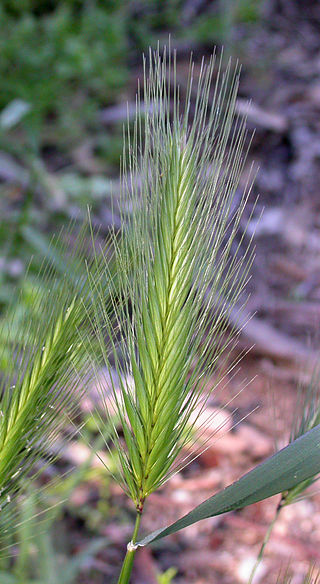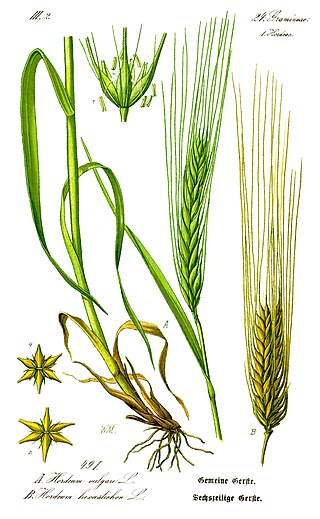
Hordeum is a genus of annual and perennial plants in the grass family. They are native throughout the temperate regions of Africa, Eurasia, and the Americas.

Ovis dalli, also known as the Dall sheep or thinhorn sheep, is a species of wild sheep native to northwestern North America. Ovis dalli contains two subspecies: Ovis dalli dalli and Ovis dalli stonei. O. dalli live in mountainous alpine habitats distributed across northwestern British Columbia, the Yukon, Northwest Territories and Alaska. They browse a variety of plants such as grasses, sedges and even shrubs such as willow, during different times of the year. They also acquire minerals to supplement their diet from mineral licks. Like other Ovis species, the rams engage in dominance contests with their horns.

Chlorophytum comosum, usually called spider plant or common spider plant due to its spider-like look, also known as spider ivy, airplane plant, ribbon plant, and hen and chickens is a species of evergreen perennial flowering plant of the family Asparagaceae. It is native to tropical and Southern Africa but has become naturalized in other parts of the world, including Western Australia and Bangladesh. Chlorophytum comosum is easy to grow as a houseplant because of its resilience, but it can be sensitive to the fluoride in tap water, which commonly gives it "burnt tips". Variegated forms are the most popular.

Elymus repens, commonly known as couch grass, is a very common perennial species of grass native to most of Europe, Asia, the Arctic biome, and northwest Africa. It has been brought into other mild northern climates for forage or erosion control, but is often considered a weed.

A foxtail is a spikelet or cluster of a grass, that serves to disperse its seeds as a unit. Thus, the foxtail is a type of diaspore or plant dispersal unit. Some grasses that produce a foxtail are themselves called "foxtail", also "spear grass". They can become a health hazard for dogs, cats, and other domestic animals, and a nuisance for people.

Triticeae is a botanical tribe within the subfamily Pooideae of grasses that includes genera with many domesticated species. Major crop genera found in this tribe include wheat, barley, and rye; crops in other genera include some for human consumption, and others used for animal feed or rangeland protection. Among the world's cultivated species, this tribe has some of the most complex genetic histories. An example is bread wheat, which contains the genomes of three species with only one being a wheat Triticum species. Seed storage proteins in the Triticeae are implicated in various food allergies and intolerances.

Hordeum jubatum, with common names foxtail barley, bobtail barley, squirreltail barley, and intermediate barley, is a perennial plant species in the grass family Poaceae. It occurs wild mainly in northern North America and adjacent northeastern Siberia. However, as it escaped often from gardens it can be found worldwide in areas with temperate to warm climates, and is considered a weed in many countries. The species is a polyploid and originated via hybridization of an East Asian Hordeum species with a close but extinct relative of Californian H. brachyantherum. It is grown as an ornamental plant for its attractive inflorescences and when done flowering for its inflorescence.

Hordeum murinum is a species of flowering plant in the grass family Poaceae, commonly known as wall barley or false barley. It is a close relative of cultivated barley.

Hordeum pusillum, also known as little barley, is an annual grass native to most of the United States and southwestern Canada. It arrived via multiple long-distance dispersals of a southern South American species of Hordeum about one million years ago. Its closest relatives are therefore not the other North American taxa like meadow barley or foxtail barley, but rather Hordeum species of the pampas of central Argentina and Uruguay. It is less closely related to the Old World domesticated barley, from which it diverged about 12 million years ago. It is diploid.
Asnières-sur-Blour is a commune in the Vienne department in the Nouvelle-Aquitaine region in western France. The commune has 180 inhabitants (2019).

Hordeum brachyantherum, known by the common name meadow barley, is a species of barley. It is native to western North America from Alaska to northern Mexico, coastal areas of easternmost Russia (Kamchatka), and a small area of coastal Newfoundland.

Barley, a member of the grass family, is a major cereal grain grown in temperate climates globally. It was one of the first cultivated grains, particularly in Eurasia as early as 10,000 years ago. Globally 70% of barley production is used as animal fodder, while 30% as a source of fermentable material for beer and certain distilled beverages, and as a component of various foods. It is used in soups and stews, and in barley bread of various cultures. Barley grains are commonly made into malt in a traditional and ancient method of preparation.
Hordeum intercedens is an diploid, annual species of wild barley known by the common names bobtail barley and vernal barley. It is native to southern California and northern Baja California, where it is an increasingly rare member of the flora in saline and alkaline soils near seasonal waterflows and vernal pool habitats. Today most occurrences are located on the Channel Islands of California; many of the occurrences known from the mainland have been extirpated in the process of land development. This is an annual grass growing erect to bent in small tufts with stems up to 40 centimeters long. The inflorescence is a green spike up to 6.5 centimeters long made up of awned spikelets between 1 and 2 centimeters long.

Hordeum marinum, commonly known as sea barley or seaside barley, is a species of flowering plant in the grass family Poaceae.
Yarraloola or Yarraloola Station is a pastoral lease that once operated as a sheep station but is currently operating as a cattle station in Western Australia.

Hordeum spontaneum, commonly known as wild barley or spontaneous barley, is the wild form of the grass in the family Poaceae that gave rise to the cereal barley. Domestication is thought to have occurred on two occasions, first about ten thousand years ago in the Fertile Crescent and again later, several thousand kilometres further east.

The Patagonian grasslands (NT0804) is an ecoregion in the south of Argentina. The grasslands are home to diverse fauna, including several rare or endemic species of birds. There are few protected areas. The grasslands are threatened by overgrazing by sheep, which supply high-quality merino wool. Efforts are being made to develop sustainable grazing practices to avoid desertification.
Hordeum muticum is a species of wild barley in the grass family Poaceae, native to the high central Andes; Peru, Bolivia, northern Chile, and northern Argentina, and introduced to Ecuador. A diploid, its closest relative is Hordeum cordobense, a lowland species with a more southerly distribution.
Hordeum cordobense is a species of wild barley in the grass family Poaceae, native to northern Argentina. A diploid found below 1,000 m (3,300 ft), its closest relative is Hordeum muticum, a highland species with a more northerly distribution.












